PORSCHE CAYNNE TURBO 2005 1.G Owners Manual
Manufacturer: PORSCHE, Model Year: 2005, Model line: CAYENNE TURBO, Model: PORSCHE CAYENNE TURBO 2005 1.GPages: 369, PDF Size: 3.17 MB
Page 281 of 369
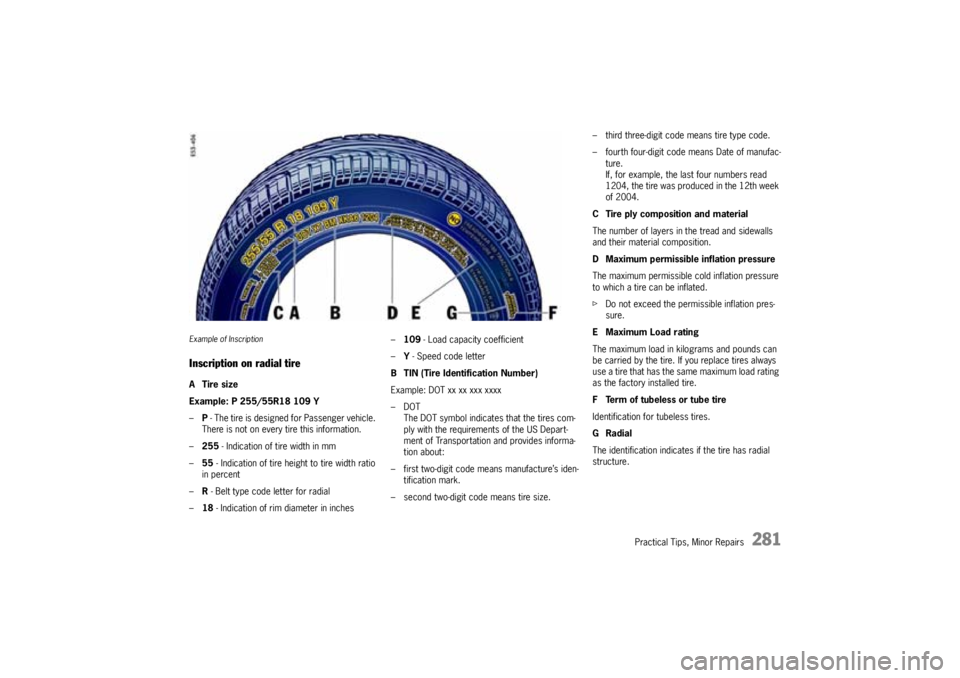
Practical Tips, Minor Repairs
281
Example of InscriptionInscription on radial tireATire size
Example: P 255/55R18 109 Y
–P - The tire is designed for Passenger vehicle.
There is not on every tire this information.
–255 - Indication of tire width in mm
–55- Indication of tire height to tire width ratio
in percent
–R- Belt type code letter for radial
–18 - Indication of rim diameter in inches–109 - Load capacity coefficient
–Y - Speed code letter
B TIN (Tire Identification Number)
Example: DOT xx xx xxx xxxx
–DOT
The DOT symbol indicates that the tires com-
ply with the requirements of the US Depart-
ment of Transportation and provides informa-
tion about:
– first two-digit code means manufacture’s iden-
tification mark.
– second two-digit code means tire size.
– third three-digit code means tire type code.
– fourth four-digit code means Date of manufac-
ture.
If, for example, the last four numbers read
1204, the tire was produced in the 12th week
of 2004.
C Tire ply composition and material
The number of layers in the tread and sidewalls
and their material composition.
D Maximum permissible inflation pressure
The maximum permissible cold inflation pressure
to which a tire can be inflated.
fDo not exceed the permissible inflation pres-
sure.
E Maximum Load rating
The maximum load in kilograms and pounds can
be carried by the tire. If you replace tires always
use a tire that has the same maximum load rating
as the factory installed tire.
F Term of tubeless or tube tire
Identification for tubeless tires.
GRadial
The identification indicates if the tire has radial
structure.
Page 282 of 369
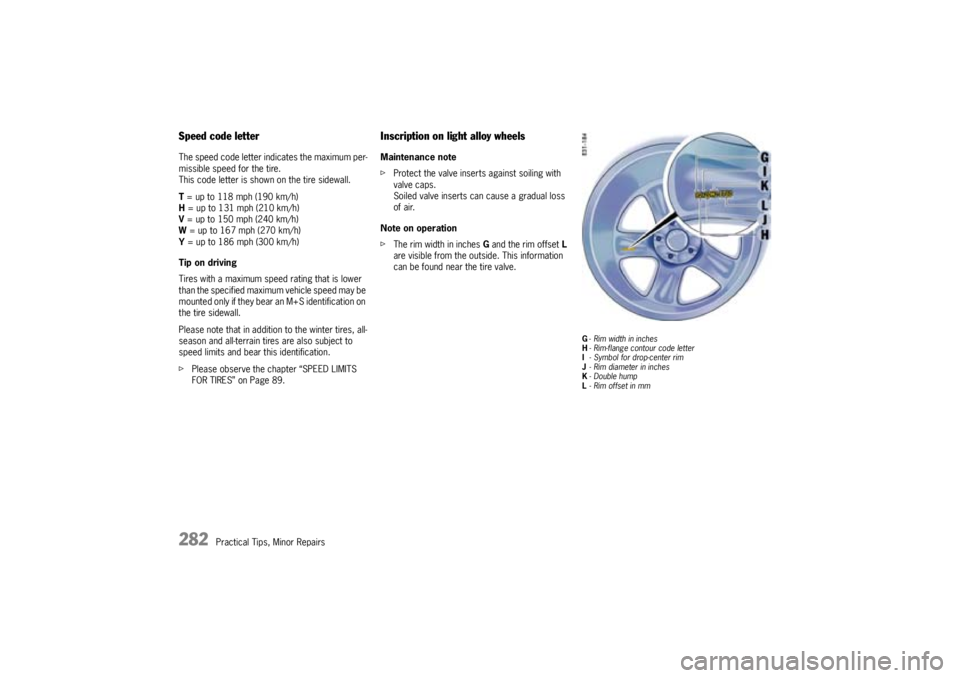
282
Practical Tips, Minor Repairs
Speed code letterThe speed code letter indicates the maximum per-
missible speed for the tire.
This code letter is shown on the tire sidewall.
T = up to 118 mph (190 km/h)
H = up to 131 mph (210 km/h)
V = up to 150 mph (240 km/h)
W = up to 167 mph (270 km/h)
Y = up to 186 mph (300 km/h)
Tip on driving
Tires with a maximum speed rating that is lower
than the specified maximum vehicle speed may be
mounted only if they bear an M+S identification on
the tire sidewall.
Please note that in addition to the winter tires, all-
season and all-terrain tires are also subject to
speed limits and bear this identification.
fPlease observe the chapter “SPEED LIMITS
FOR TIRES” on Page 89.
Inscription on light alloy wheelsMaintenance note
fProtect the valve inserts against soiling with
valve caps.
Soiled valve inserts can cause a gradual loss
of air.
Note on operation
fThe rim width in inches G and the rim offset L
are visible from the outside. This information
can be found near the tire valve.
G-Rim width in inches
H- Rim-flange contour code letter
I- Symbol for drop-center rim
J- Rim diameter in inches
K-Double hump
L- Rim offset in mm
Page 283 of 369
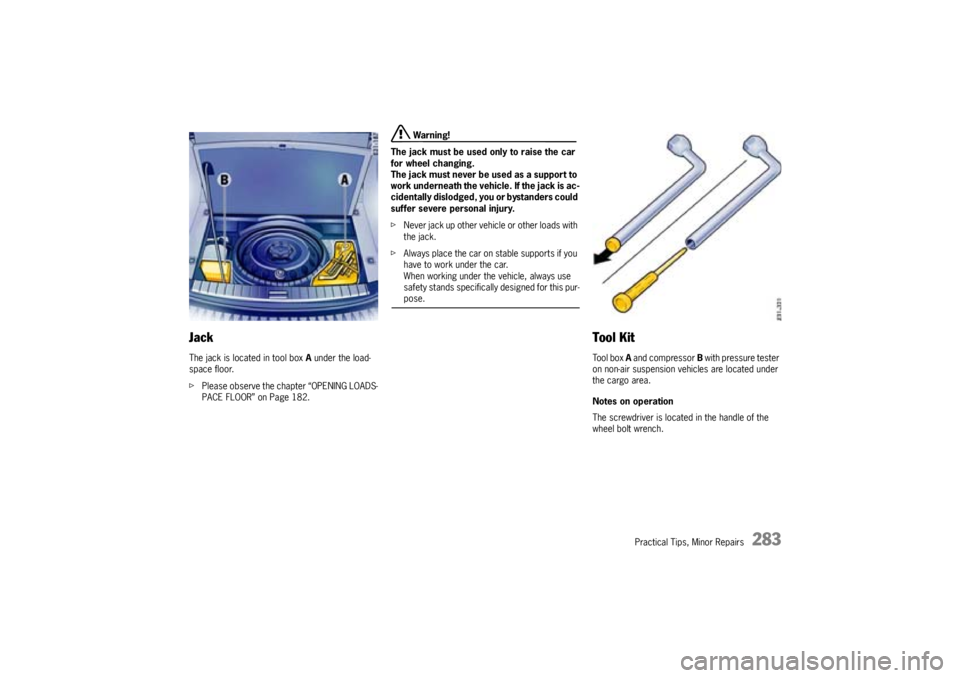
Practical Tips, Minor Repairs
283
JackThe jack is located in tool box A under the load-
space floor.
fPlease observe the chapter “OPENING LOADS-
PACE FLOOR” on Page 182.
Warning!
The jack must be used only to raise the car
for wheel changing.
The jack must never be used as a support to
work underneath the vehicle. If the jack is ac-
cidentally dislodged, you or bystanders could
suffer severe personal injury.
fNever jack up other vehicle or other loads with
the jack.
fAlways place the car on stable supports if you
have to work under the car.
When working under the vehicle, always use
safety stands specifically designed for this pur-pose.
Tool KitTool box A and compressor B with pressure tester
on non-air suspension vehicles are located under
the cargo area.
Notes on operation
The screwdriver is located in the handle of the
wheel bolt wrench.
Page 284 of 369

284
Practical Tips, Minor Repairs
Lifting the Vehicle with a Lifting
Platform or Garage liftfThe car must be raised only at the illustrated
jacking points.
Please observe the chapter “LIFTING THE VE-
HICLE WITH A JACK” on Page 290.
Please observe the chapter “RAISING VEHICLE
WITH THE JACK” on Page 230.
fLifting at any other place may damage the ve-
hicle or may result in personal injury.
Caution!
Risk of serious damage to the engine or the
vehicle.
fNever lift the vehicle by the engine, transmis-
sion or axles.
fDo not damage any sensitive components in the vicinity of the jacking points.
A- Front jacking points platform lift
B- Front jacking point garage liftPlatform liftfBefore the car is driven on to a lifting platform,
it must be ensured that there is enough space
between the lifting platform and the vehicle.
C- Rear jacking points platform lift
D- Rear jacking point garage liftGarage liftA garage lift must be used only at the illustrated
jacking points.
fLifting at any other place may damage the ve-
hicle or may result in personal injury.
Page 285 of 369
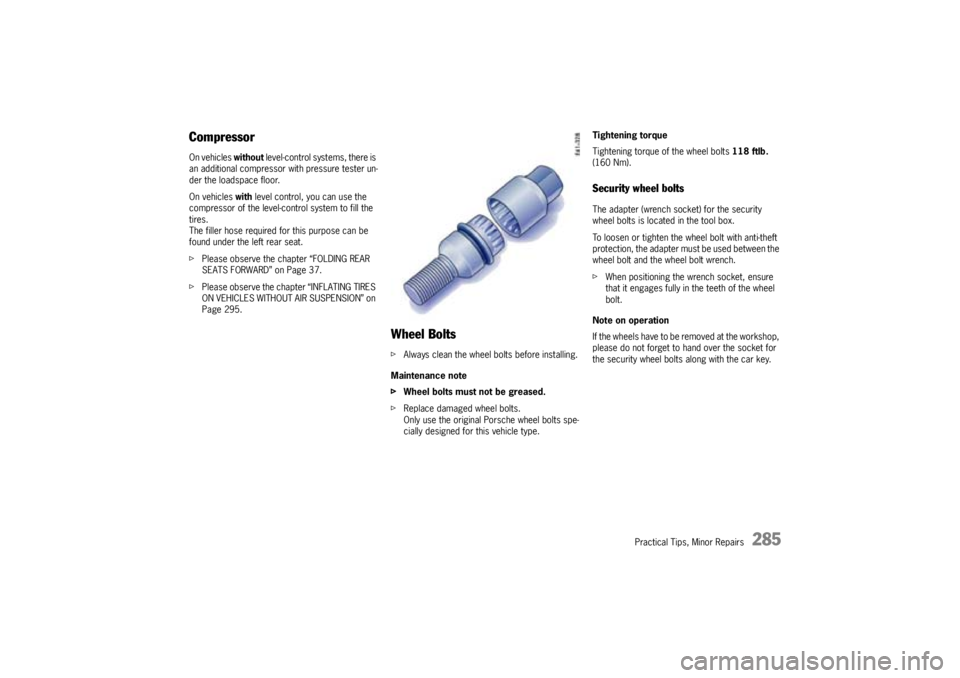
Practical Tips, Minor Repairs
285
CompressorOn vehicles without level-control systems, there is
an additional compressor with pressure tester un-
der the loadspace floor.
On vehicles with level control, you can use the
compressor of the level-control system to fill the
tires.
The filler hose required for this purpose can be
found under the left rear seat.
fPlease observe the chapter “FOLDING REAR
SEATS FORWARD” on Page 37.
fPlease observe the chapter “INFLATING TIRES
ON VEHICLES WITHOUT AIR SUSPENSION” on
Page 295.
Wheel BoltsfAlways clean the wheel bolts before installing.
Maintenance note
fWheel bolts must not be greased.
fReplace damaged wheel bolts.
Only use the original Porsche wheel bolts spe-
cially designed for this vehicle type.Tightening torque
Tightening torque of the wheel bolts 118 ftlb.
(160 Nm).
Security wheel boltsThe adapter (wrench socket) for the security
wheel bolts is located in the tool box.
To loosen or tighten the wheel bolt with anti-theft
protection, the adapter must be used between the
wheel bolt and the wheel bolt wrench.
fWhen positioning the wrench socket, ensure
that it engages fully in the teeth of the wheel
bolt.
Note on operation
If the wheels have to be removed at the workshop,
please do not forget to hand over the socket for
the security wheel bolts along with the car key.
Page 286 of 369

286
Practical Tips, Minor Repairs
Changing Wheels
Warning!
Failure to follow these instructions may result
in serious personal injuries to you or to by-
standers.
Before changing the wheel
fIf you have a flat tire, move a safe distance off
the road. Turn the emergency flasher on and
use other warning devices to alert other motor-
ists.
fDo not park your vehicle where it may contact
dry grass, brush or other flammable materials.
The hot parts of the exhaust system could set
such materials on fire, thereby causing both
property damage and severe or fatal physical
injury.
fPassengers must not be in the vehicle when it
is jacked up.
fBefore you change a wheel, be sure the ground
is level and firm. If necessary, use a board un-
der the jack to ensure that the jack does not
sink into the ground.
fSet the parking brake and block the wheels op-
posite the flat tire on the other side of the vehi-
cle.While operating the jack
fThe jack is only to be used for changing a
wheel. Do not use it as a support to work under
the car.
fThe car must be jacked up only at the illustrat-
ed jacking points.Lifting at any other place
may damage the vehicle or may result in per-
sonal injury. Never jack the car up by the body
or the bumpers.
fFor safety reasons do not use tire inflating bot-
tles. Do not use commercially available sealant
bottles.Use only the tire inflating bottle locat-
ed in the luggage compartment.
Sequence of operation
Warning!
The jack must be used only to raise the car
for wheel changing.The jack must never be
used as a support to work underneath the ve-
hicle. If the jack is accidentally dislodged,
you or bystanders could suffer severe per-
sonal injury.
fNever jack up other vehicles or other loads
with the jack.
fAlways place the car on stable supports if you
have to work under it. When working under the
vehicle, always use safety stands specifically designed for this purpose.
fPlease use a suitable knee rest to protect your
clothing against soiling.
Page 287 of 369
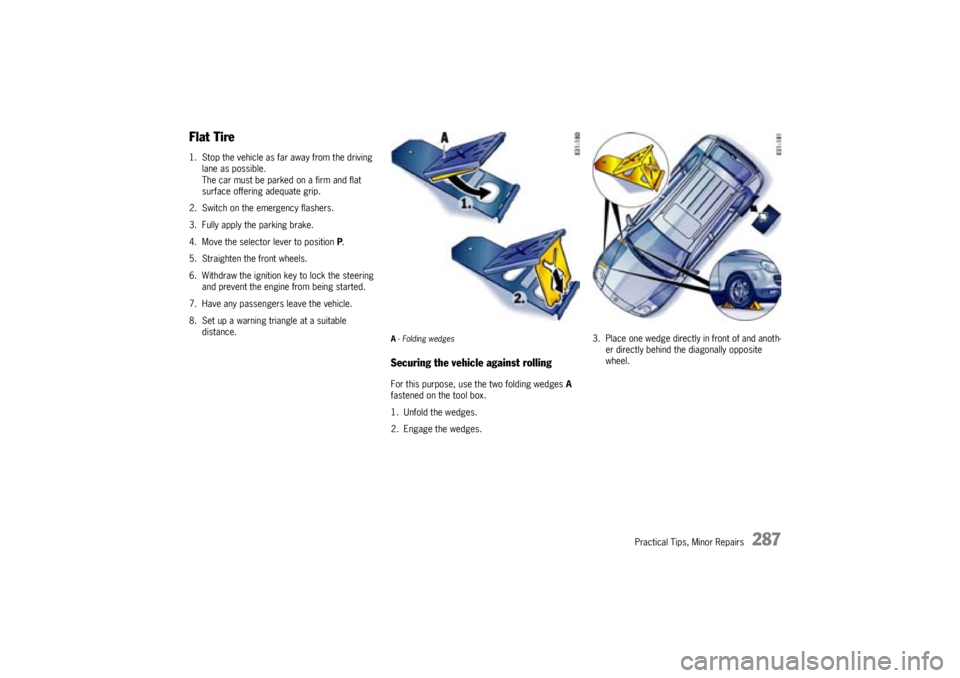
Practical Tips, Minor Repairs
287
Flat Tire1. Stop the vehicle as far away from the driving
lane as possible.
The car must be parked on a firm and flat
surface offering adequate grip.
2. Switch on the emergency flashers.
3. Fully apply the parking brake.
4. Move the selector lever to position P.
5. Straighten the front wheels.
6. Withdraw the ignition key to lock the steering
and prevent the engine from being started.
7. Have any passengers leave the vehicle.
8. Set up a warning triangle at a suitable
distance.
A- Folding wedgesSecuring the vehicle against rollingFor this purpose, use the two folding wedges A
fastened on the tool box.
1. Unfold the wedges.
2. Engage the wedges.3. Place one wedge directly in front of and anoth-
er directly behind the diagonally opposite
wheel.
Page 288 of 369
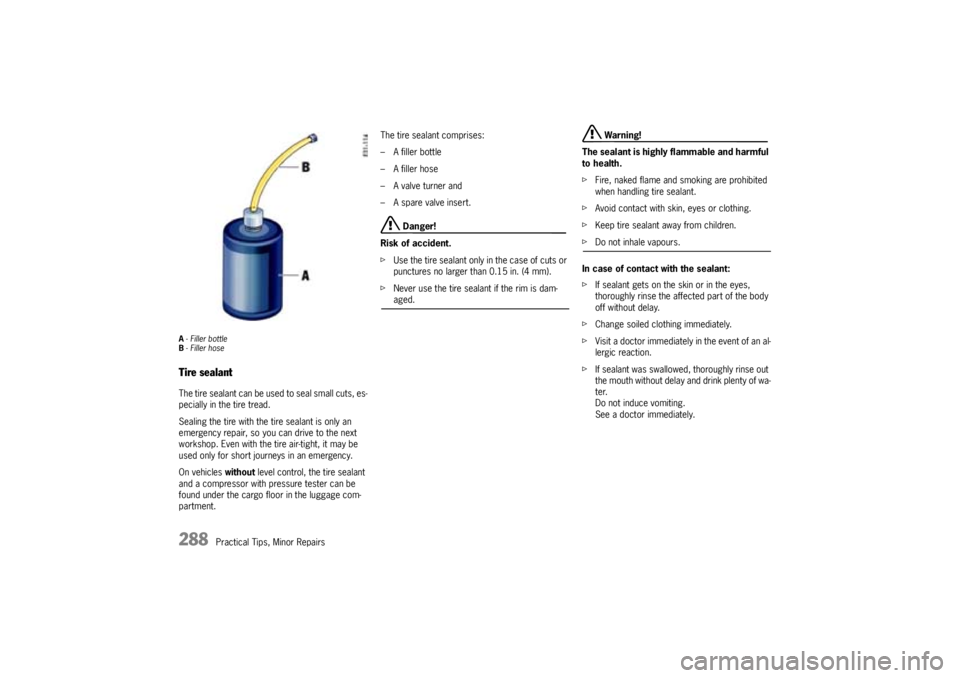
288
Practical Tips, Minor Repairs
A- Filler bottle
B- Filler hoseTire sealantThe tire sealant can be used to seal small cuts, es-
pecially in the tire tread.
Sealing the tire with the tire sealant is only an
emergency repair, so you can drive to the next
workshop. Even with the tire air-tight, it may be
used only for short journeys in an emergency.
On vehicles without level control, the tire sealant
and a compressor with pressure tester can be
found under the cargo floor in the luggage com-
partment.The tire sealant comprises:
– A filler bottle
– A filler hose
– A valve turner and
– A spare valve insert.
Danger!
Risk of accident.
fUse the tire sealant only in the case of cuts or
punctures no larger than 0.15 in. (4 mm).
fNever use the tire sealant if the rim is dam-aged.
Warning!
The sealant is highly flammable and harmful
to health.
fFire, naked flame and smoking are prohibited
when handling tire sealant.
fAvoid contact with skin, eyes or clothing.
fKeep tire sealant away from children.
fDo not inhale vapours.
In case of contact with the sealant:
fIf sealant gets on the skin or in the eyes,
thoroughly rinse the affected part of the body
off without delay.
fChange soiled clothing immediately.
fVisit a doctor immediately in the event of an al-
lergic reaction.
fIf sealant was swallowed, thoroughly rinse out
the mouth without delay and drink plenty of wa-
ter.
Do not induce vomiting.
See a doctor immediately.
Page 289 of 369
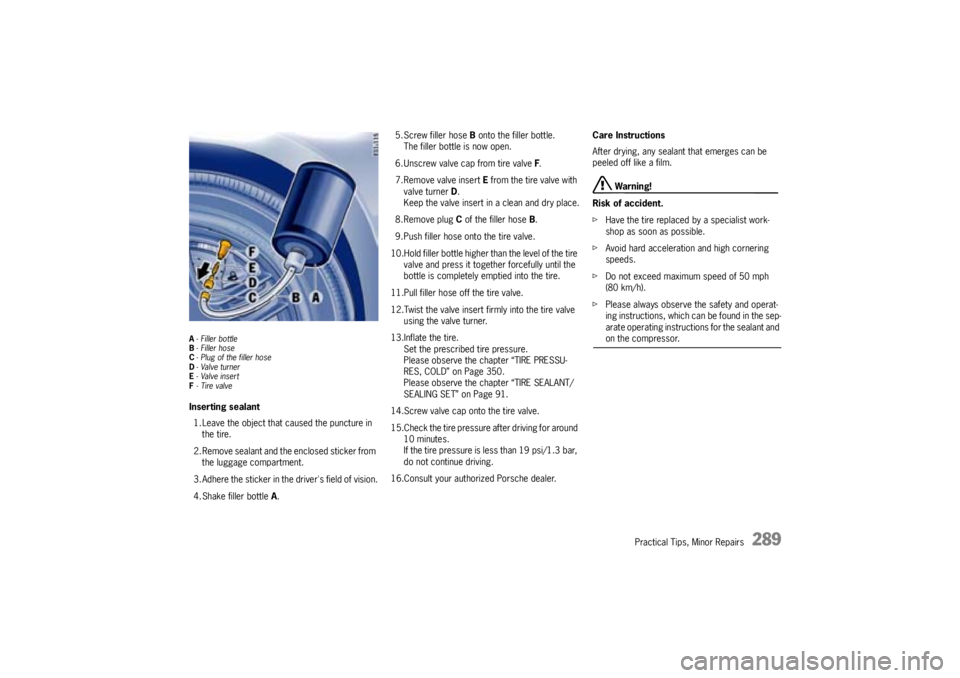
Practical Tips, Minor Repairs
289
A- Filler bottle
B- Filler hose
C- Plug of the filler hose
D-Valve turner
E-Valve insert
F- Tire valveInserting sealant
1. Leave the object that caused the puncture in
the tire.
2. Remove sealant and the enclosed sticker from
the luggage compartment.
3. Adhere the sticker in the driver's field of vision.
4. Shake filler bottle A.5. Screw filler hose B onto the filler bottle.
The filler bottle is now open.
6. Unscrew valve cap from tire valve F.
7. Remove valve insert E from the tire valve with
valve turner D.
Keep the valve insert in a clean and dry place.
8. Remove plug C of the filler hose B.
9. Push filler hose onto the tire valve.
10.Hold filler bottle higher than the level of the tire
valve and press it together forcefully until the
bottle is completely emptied into the tire.
11.Pull filler hose off the tire valve.
12.Twist the valve insert firmly into the tire valve
using the valve turner.
13.Inflate the tire.
Set the prescribed tire pressure.
Please observe the chapter “TIRE PRESSU-
RES, COLD” on Page 350.
Please observe the chapter “TIRE SEALANT/
SEALING SET” on Page 91.
14.Screw valve cap onto the tire valve.
15.Check the tire pressure after driving for around
10 minutes.
If the tire pressure is less than 19 psi/1.3 bar,
do not continue driving.
16.Consult your authorized Porsche dealer.Care Instructions
After drying, any sealant that emerges can be
peeled off like a film.
Warning!
Risk of accident.
fHave the tire replaced by a specialist work-
shop as soon as possible.
fAvoid hard acceleration and high cornering
speeds.
fDo not exceed maximum speed of 50 mph
(80 km/h).
fPlease always observe the safety and operat-
ing instructions, which can be found in the sep-
arate operating instructions for the sealant and on the compressor.
Page 290 of 369

290
Practical Tips, Minor Repairs
Lifting the vehicle with a jack
Warning!
Danger of injury. The car may slip off the
jack.
fMake sure that no one is in the vehicle when
jacking up and changing a wheel.
fNever jack up the vehicle when it is parked on
a surface that slopes up, down or to the side.
fUse the jack only to raise the car for wheel
changing.
fAlways place the car on stable supports if work
has to be carried out under the car.
The car jack is not suitable for this.
Danger of injury if the level-control system
operates during the wheel change.
fSet the car to jacking mode before raising the
car.
Please observe the chapter “RAISING VEHICLE
WITH THE JACK” on Page 230.
Risk of injury and damage if the vehicle is not
secured.
fSecure the vehicle against rolling.
fPlease observe the chapter “SECURING THE VEHICLE AGAINST ROLLING” on Page 287.Maintenance note
The jacking point on the vehicle must be free of
dirt.
1. Slightly slacken the wheel bolts of the wheel to
be changed.
2. Only set up the jack at the rear jacking point
designed for the purpose. The jack foot must
be in contact over its whole area and must be
positioned directly below the head piece.
Use a suitable support if necessary.
3. Hold jack still and wind it up until its head en-
ters the jacking point on the vehicle.
Only jack vehicle up until the wheel to be chan-
ged is completely off the ground.
4. After lowering the vehicle, remove the jack.
Front jacking pointJacking point base
fSet up jack only at the points provided A or B.